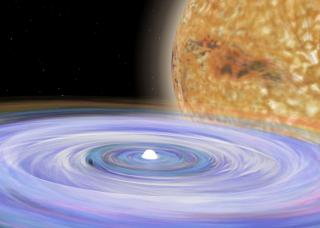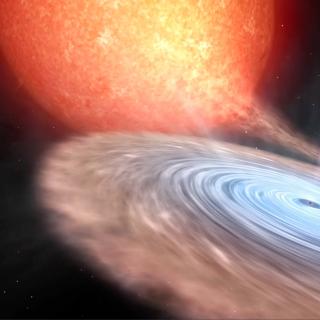Bibcode
Corral-Santana, J. M.; Casares, J.; Munoz-Darias, T.; Tyndall, A. A.; Zurita, C.; Rodríguez-Gil, P.; Shahbaz, T.; Torres, M. A.
Bibliographical reference
Science, 339, 1048-1051 (2013)
Advertised on:
3
2013
Journal
Citations
89
Refereed citations
84
Description
Stellar-mass black holes (BHs) are mostly found in X-ray transients, a
subclass of X-ray binaries that exhibit violent outbursts. None of the
50 Galactic BHs known show eclipses, which is surprising for a random
distribution of inclinations. Swift J1357.2-0933 is a very faint X-ray
transient detected in 2011. On the basis of spectroscopic evidence, we
show that it contains a BH in a 2.8 h orbital period. Further, high-time
resolution optical light curves display profound dips without X-ray
counterparts. The observed properties are best explained by the presence
of an obscuring toroidal structure moving outwards in the inner disk
seen at very high inclination. This observational feature should play a
key role in models of inner accretion flows and jet collimation
mechanisms in stellar-mass BHs.
Related projects

Binary Stars
The study of binary stars is essential to stellar astrophysics. A large number of stars form and evolve within binary systems. Therefore, their study is fundamental to understand stellar and galactic evolution. Particularly relevant is that binary systems are still the best source of precise stellar mass and radius measurements. Research lines
Pablo
Rodríguez Gil

Black holes, neutron stars, white dwarfs and their local environment
Accreting black-holes and neutron stars in X-ray binaries provide an ideal laboratory for exploring the physics of compact objects, yielding not only confirmation of the existence of stellar mass black holes via dynamical mass measurements, but also the best opportunity for probing high-gravity environments and the physics of accretion; the most
Montserrat
Armas Padilla